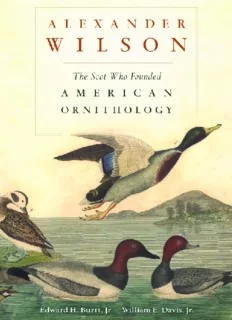
Alexander Wilson: The Scot Who Founded American Ornithology PDF
Preview Alexander Wilson: The Scot Who Founded American Ornithology
Alexander Wilson AlexAnder Wilson The Scot Who Founded American Ornithology EdWArd H. Burtt, Jr. WilliAm E. dAvis, Jr. The Belknap Press of Harvard University Press Cambridge, Massachusetts London, England 2013 Frontispiece: Portrait of Alexander Wilson attributed to thomas sully, most likely painted around the time of Wilson’s election to the American Philosophical society in 1812. (From the collection of the American Philosophical society, gift of dr. Nathaniel Chapman, 1822.) Copyright © 2013 by the President and Fellows of Harvard College All rights reserved Printed in Canada Book design by dean Bornstein Library of Congress Cataloging-in-Publication Data Burtt, Edward H., Jr., 1948– Alexander Wilson : the scot who founded American ornithology / Edward H. Burtt, Jr., William E. davis, Jr. pages cm includes bibliographical references and index. ISBN 978-0-674-07255-8 (alk. paper) 1. Wilson, Alexander, 1766–1813. 2. Ornithologists—united states—Biography. 3. Ornithology—united states—History. 4. Wilson, Alexander, 1766–1813. American ornithology—illustrations. 5. Birds—united states—Pictorial works. i. davis, William E., Jr., 1936– ii. title. Ql31.W7B87 2013 598.092—dc23 [B] 2012036742 To my best friend, Thelma, with love—Jed } } } To my wife, Betsy Davis, with love—Ted Contents Preface . ix 1. themes in Wilson’s life and Writings . 1 2. A varied life . 13 3. illustrating American Ornithology . 63 4. Pioneer Ornithologist . 281 5. Wilson’s legacy . 331 Appendix A. On the shoulders of Giants: Wilson’s Predecessors . 355 Appendix B. Wilson’s Contemporaries and Correspondents . 385 Notes . 413 selected Bibliography . 429 Acknowledgments . 433 index . 437 Preface Over the last ten years our colleagues, students, friends, and families occa- sionally asked, “What are you doing?” to which we responded enthusiastical- ly, “Writing a book about Alexander Wilson: naturalist, illustrator, and Father of American Ornithology.” that response usually elicited a noncommittal “how interesting” or occasionally, bewilderment followed by “Wasn’t that Audubon?” rarely genuine interest led to the question, “Was Wilson’s War- bler named after him?” the species in question might be Wilson’s storm- Petrel, Wilson’s snipe, Wilson’s Plover, or Wilson’s Phalarope. Wilson has more species named after him than any other American ornithologist, one measure of his stature among American ornithologists. to provide context for understanding Wilson’s achievement, the first chapter explores themes in Wilson’s life, writings, art, and science. the second chapter is a brief biography. Chapter 3 explains the publication pro- cess of the early nineteenth century. But at its core this chapter and the book are about Wilson’s observations of birds and the artwork he created for the plates in his nine-volume American Ornithology. the drawings vary from a few lines and notes penciled in the field to remind him of shape and color— for example, the simple sketch of a Canvasback—to detailed pen, ink, and watercolor paintings, such as his perched red-tailed Hawk, a stunning work of art. most of Wilson’s drawings and draft plates are reproduced here for the first time. Collectively they are witness to his artistic achievement, his development as an artist, his method of working, his observational skill, and his scientific insight. the detail and elegance of his portraits are astonishing, especially when you realize that the knowledge portrayed in these illustra- tions was based on Wilson’s own discoveries, that many of these species were first described by him, and that the ecology and behavior evident in the art- work were unknown until he observed and illustrated them. Beyond his artistic achievements, Wilson wrote at length about the ecol- . ix .
Description: